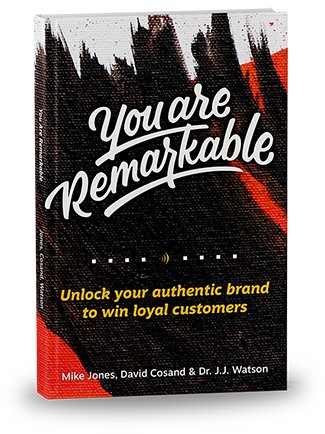Podcast: Play in new window | Download
Subscribe: RSS
Competition. What comes to mind? An epic struggle between two teams on a sports field? Candidates vying for an open position at a fast-growing, exciting tech company? Perhaps something more biblical, say, David vs Goliath?
For most of us leading and building B2B brands, the first thing that comes to mind is the other companies vying for our customers and clients.
The competition is ‘the other guys’ and we often know something about them. We may even have seen them at an event, met them, we may be friends with them, and quite possibly used to work for them.
And in my experience running a creative branding agency in Phoenix, as we work with, advise, and help build remarkable B2B brands, the activities of the competition (especially of the marketing variety) are something my clients care very much about. They follow their press releases, size up their booth at the tradeshow, and maybe even set up a friendly meeting with their counterpart in the other firm, and both attempt a little competitive-but-friendly game of digging for dirt.
Researching what competition is up to always seems to sound like a good idea. Stay ahead of the curve. Keep up with the Joneses. Get a leg up. Don’t get left behind.
And I certainly don’t disagree. In fact, I think there’s an incredibly crucial place in your B2B brand strategy for competitive analysis. But that said, I think many brands misplace the energy spent on keeping tabs on their competition. So let’s talk about that for a minute.
How Remarkable Brands Think About Competitive Research
Think about the remarkable brands in your industry — or really in any industry. Maybe consider a Nike, Apple, Amazon, or Coca-cola. Think for a moment about Southwest Airlines or Chick-fil-A or Barry-Wehmiller.
Now answer the question, “Do these companies focus more on their own brands or their competitors’ brands?” I’m pretty sure the answer is the former: they are far, far more focused on their own brand than what their competition is doing. Chick-fil-A doesn’t primarily train its staff by showing them what McDonald’s does and then saying ‘do the opposite’. They teach them how to act the Chick-fil-A way first and foremost. They create their own culture, not just ‘someone else’s but different’.
‘Outside-In’ Branding
The opposite of these brands’ strategy (when it comes to the competition) is ‘outside-in’ branding. That’s when you’re far more worried about what everyone else is doing than what your brand is doing. Your brand is less about what’s really true about your organization and more about how to position it amongst or against the competition.
I do think there’s value in making sure you’re looking around to see what everyone else is doing (just like a runner in the lead has to take quick stock of the pack every now and again). And we’ll get to some approaches for doing that right later in this article. But I think there’s a lot of temptation for brands to focus way too much on the competition, causing them to lose sight of their own authentic (and compelling) identity.
The real fundamental issue with ‘Outside-In’ branding: you are forever a follower. Your brand never leads. It can’t. It’s created from either the negative space between your competitors or from some herd-mentality (or some mutated amalgamation of the two). Here are some specific issues that arise for ‘outside-in’ brands:
- Moved by the competition. Because in some way, shape, or form your brand is really built on what your competitors’ brands are, what they do causes your brand to shift – whether actually because you choose to shift or just in terms of perception in the minds of your customers.
- Reactionary. Very much related to the point above, you are put into a position of reaction. Everything you do is really just based on what your competition does. And this means they control you to some degree.
- Low-grounded. You can’t hold the high ground if you’re not in the lead. You’re always trying to surmount the last hill the leader has already climbed while they’re hustling up the next one.
So if we’re not going to use an ‘outside-in’ strategy, what should we do?
‘Inside-Out’ Branding
These (and all other remarkable brands) are built from the inside out. They are focused on their own identity first and foremost: core values, personality, behaviors, and communication. They know that remarkable brands are leaders, not followers. These brands don’t get caught watching all the other players all the time. They keep the eye on the ball and get to where it will be before everyone else.
There are some incredible benefits from this ‘inside-out’ brand strategy:
- Confidence. Inside-out brands are focused on knowing themselves and thus can make decisions, act, and communicate from a place of surety and solidity. There’s far less wavering for these brands.
- Vision. Followers don’t look any further ahead than the person in front of them. Leaders must create the path. There’s no one to follow when you’re at the head of the pack.
- Action. Too much focus on everyone else will often lead to paralysis. Who do we follow? How do we know who’s actually getting it right? How do we copy and yet still be original? This kind of thinking leads to indecision, infighting, and ultimately inaction. Organizations building from the inside out have to act. You can’t lead if you never step forward.
- Leadership. Leading puts you ahead. And being out in front puts the focus on you. And I don’t just mean from your competitors. If you’re truly building a remarkable, leading brand, your customers (and soon-to-be-customers) are going to notice. They’re going to be inspired. They are going to want to follow the leader, not those brands who are just trying to keep up.
So…Why Bother with Competitive Research at All?
So we’re going to build a remarkable, ‘inside-out ‘ brand. We won’t get caught following the competition. We’re going to have a vision, be out in front, and really lead. Is there no place then for competitive analysis? Should we even care at all what they’re doing?
Yes, we absolutely should care about the competition. But we have to frame our analysis correctly:
We research the competition, not to instigate, but to validate our branding efforts. Competitive research is great. It’s a fantastic tool but it has to be applied at the right point and with the right focus to help us build a remarkable, ‘inside-out’ brand. It has to serve the work we’ve already done to find our authentic identity. We don’t create an identity out of our competitive research. We validate that it truly is different and unique.
So here are four critical ways to use your competitive research right in building your remarkable brand.
1.) Validate your own unique position in the market.
You’ve put in the time and effort to identify and define your brand values, personality, story, and perhaps even started to build key assets like a logo, name, tagline, and colors. But if you never do any competitive research, you’ll likely find yourself creating things that may look a lot like a competitor’s brand. You certainly don’t want to make a certain shade of red your primary brand color when a direct competitor is using one that is nearly identical!
There should be one consistent thought as you research your competition. “Is what we’re creating truly unique?” Let’s not get caught down the road building a brand that doesn’t truly showcase our unique identity. Competitive research is a great tool to protect against this.
2.) Understand the context of your marketplace.
What terms do you find consistently across your competitors’ messaging? Which visuals keep popping up? What overall experience are customers getting from your competitors’ combined efforts?
While it may not be prudent to simply pick up these terms and images and use them yourself (again, you are trying to build a unique brand, aren’t you?), but they do give you clues into the things that your customers are seeing in the industry. You can better get inside their head and even link these ‘industry terms’ or even buzzwords with your own unique, clear and compelling terms.
And let’s be honest: many brands use buzzwords, not because customers understand them, but because it makes them feel like they’re projecting expertise. The reality is far different though: customers are often more confused and frustrated than they are helped by these terms. If you’ve done your homework and know which terms are common, what a fantastic opportunity to bring your authentic brand to bear on explaining the concepts of your work in terms that are far clearer and helpful.
3.) Know and communicate clearly your competitive advantage.
If you never know what your competitors are saying and doing, it’s hard to answer the question from a customer, “Well, what makes you any better than them?” Use your competitive research to better arm your marketing communications and sales messaging for that moment in the customer’s journey when they’re ready to make a decision to stop caring about your competitors and really focus on you.
4.) Copy tactics, not strategy
Competitive research can be a fantastic source of new tactics. Watch how competitors use their websites, social media, and other assets. See which channels they’re choosing to invest in. Observe which customer segments they’re focusing on now. These can all be great sources of new tactical ideas for your own marketing and sales efforts.
The key: differentiate tactics from a strategy. There is a slippery slope here to wholesale copy a competitor’s approach and when you do you’ll find yourself adopting their strategy as well. The problem? Their strategy is predicated on their own strengths and weaknesses, their own brand identity. And yours is different. Yours is unique to you (as no two organizations are the same). And a wholesale strategy copy will backfire quickly as you can’t claim the same identity with the exact same strengths.
So use competitive research to source tactics and then apply your own unique strategy lens to them. Make them yours. Don’t wholesale copy their website, chase their audience segment, or adopt their messaging. Instead, use them as inspiration to further strengthen your own unique brand identity.
Competitive Research Empowers B2B Brands
Competitive research, done right, is an incredibly powerful tool to validate your brand identity. I highly recommend employing it to strengthen your own efforts and build a brand that is truly remarkable.
If you’re looking for some help with your competitive research we have a free competitor analysis tool that might be a good place to start. And if you want to go deeper sign up for our newsletter, join our next Brand Roundtable Chat, or even give me a call. I’d love to help you any way I can.



